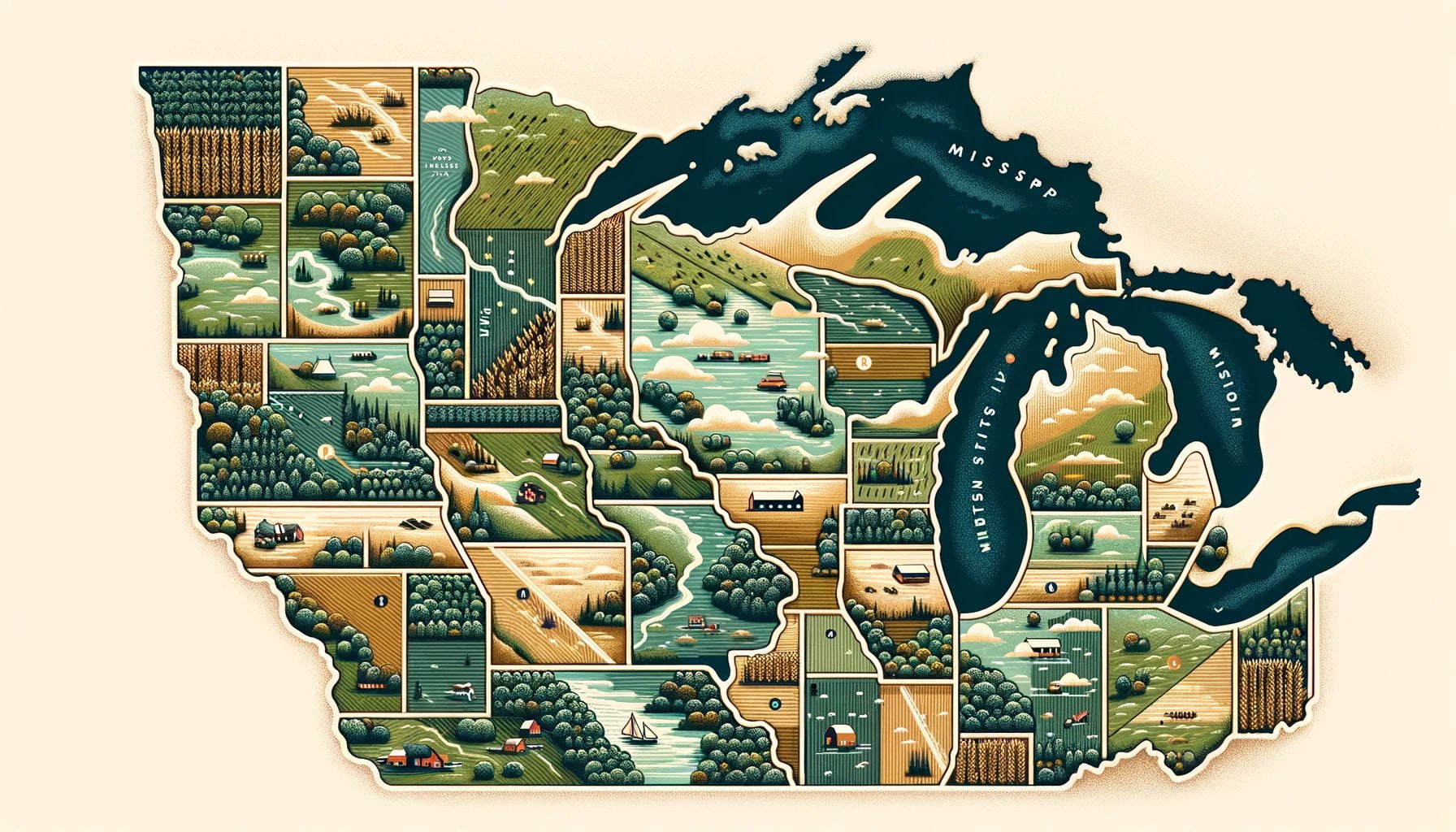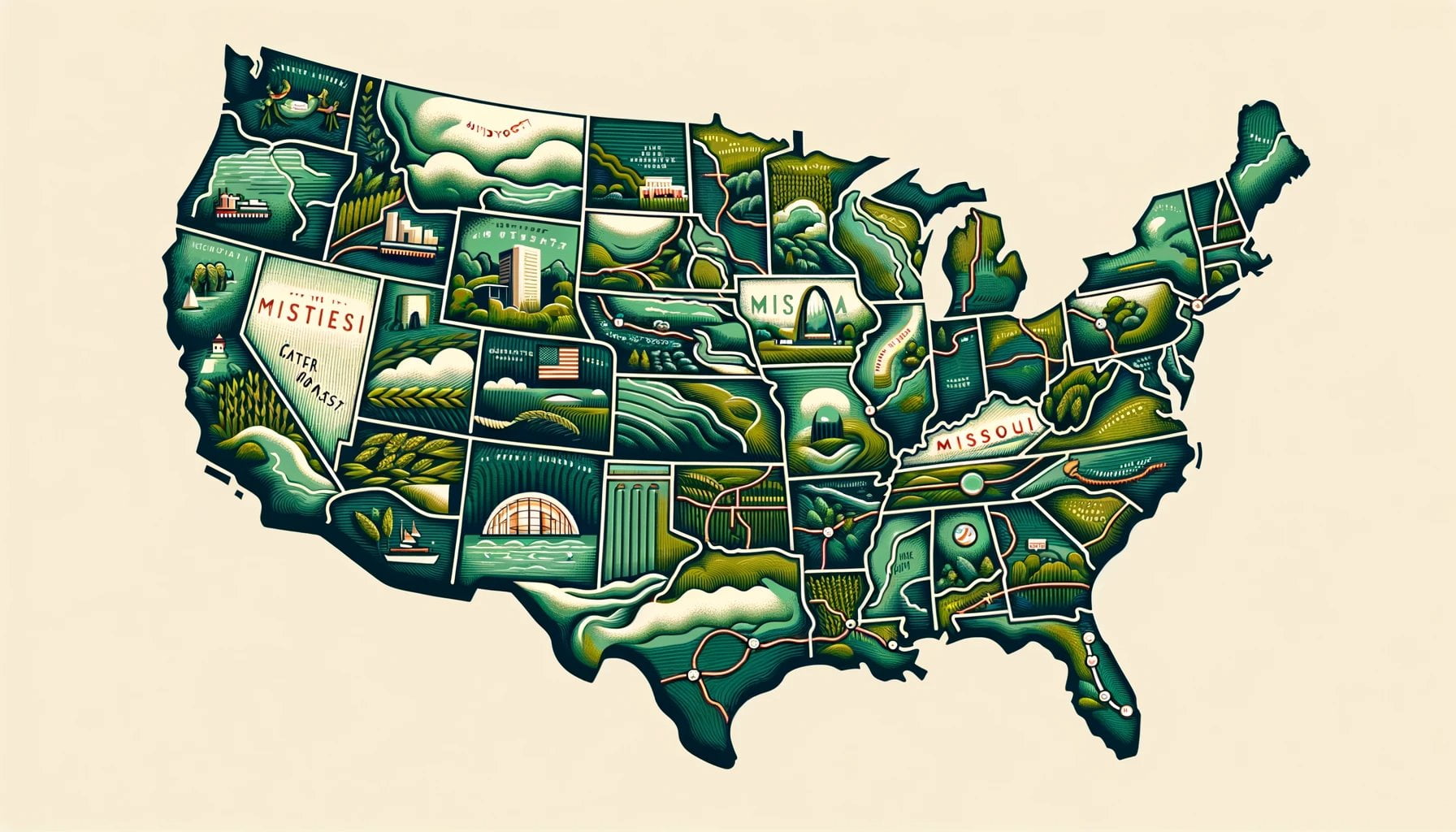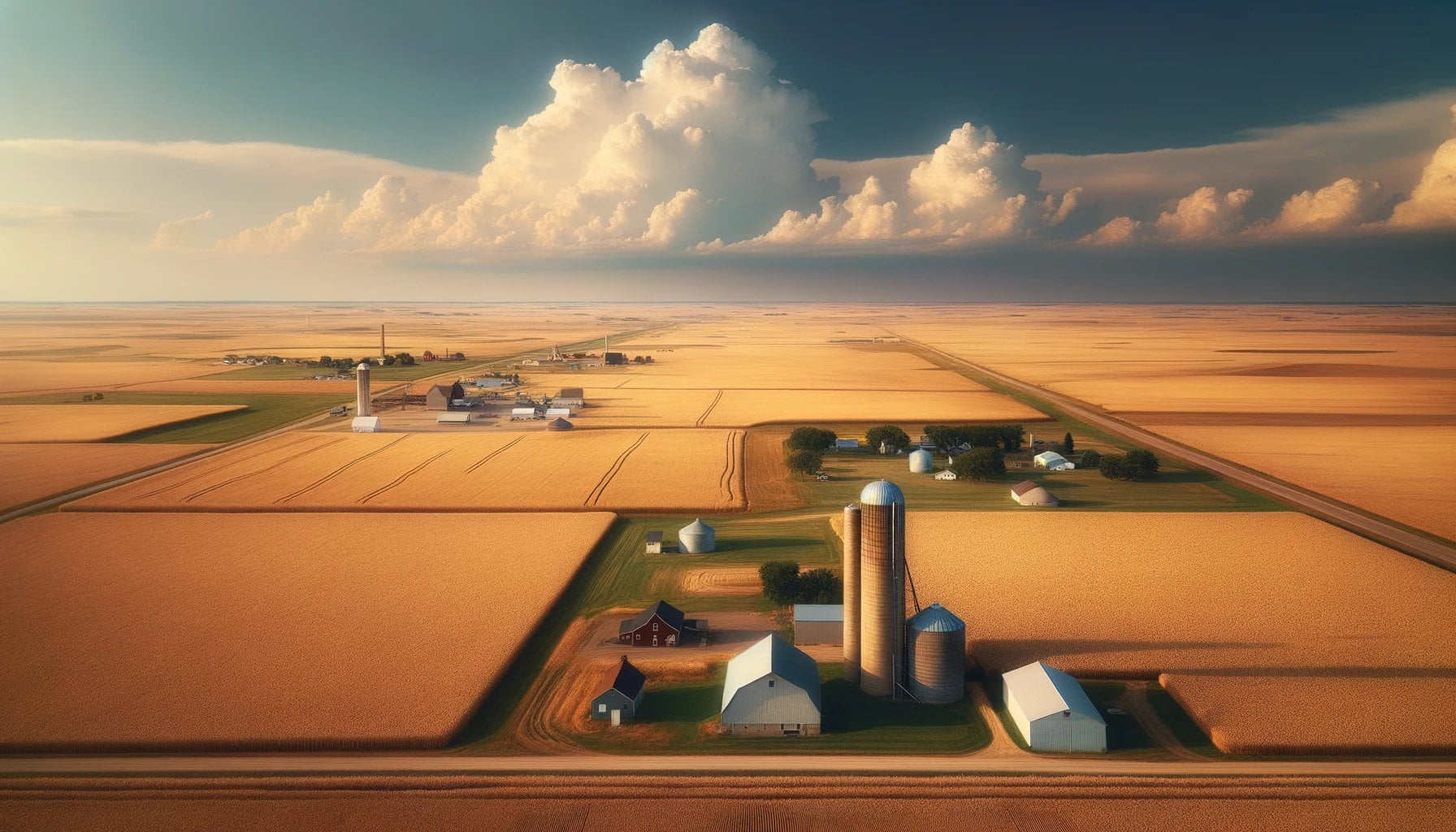Welcome to “The Size of the Midwest: Unveiling the Region’s Vast Expanse,” where we delve into the intriguing question of just how large the Midwest region truly is. As a seasoned geographer with a deep understanding of spatial analysis, I am here to guide you through the complexities of defining and analyzing regional boundaries. Drawing on my extensive expertise in regional planning and research, we will uncover the significance of geographic demarcations and explore the size and scope of this fascinating region. So, let us embark on this exploration and unravel the vast expanse of the Midwest together.

Key Takeaways:
- The Midwest region of the United States covers over 750,000 square miles of land and is divided into the East North Central Division and the West North Central Division by the U.S. Census Bureau.
- The Midwest region overlaps with other regions such as the Great Lakes, the Great Plains, and the Bible Belt.
- As of 2020, the Midwest is home to more than 68 million people.
- The East North Central Division, which includes states like Illinois, Indiana, Michigan, Ohio, and Wisconsin, is part of the Great Lakes region.
How large is the Midwest region?
The Midwest region of the United States is a vast expanse of land, encompassing over 750,000 square miles. To put this into perspective, that’s roughly equivalent to the combined area of Texas, California, and Montana! But what truly defines the Midwest region and sets it apart from other parts of the country? Let’s explore the boundaries and dimensions of this fascinating region.
Defining the Midwest Region
The Midwest region is divided into two divisions by the U.S. Census Bureau: the East North Central Division and the West North Central Division. These divisions help us understand the nuances and characteristics that make up the Midwest.
East North Central Division
The East North Central Division includes five states: Illinois, Indiana, Michigan, Ohio, and Wisconsin. These states are often associated with the Great Lakes region due to their proximity to the immense freshwater lakes that define this area. Situated in the heart of the country, these states form a vital part of the Midwest’s cultural, economic, and political landscape.
West North Central Division
On the other hand, the West North Central Division comprises seven states: Iowa, Kansas, Minnesota, Missouri, Nebraska, North Dakota, and South Dakota. This division is often referred to as the Great Plains region, known for its expansive prairies, agricultural productivity, and iconic landscapes. These states add to the rich diversity of the Midwest, both geographically and culturally.
Overlapping Regions
While the Midwest region has its distinct boundaries, it’s essential to acknowledge that it intersects with other regions, adding further complexity to its identity. The Midwest shares its borders with regions such as the Great Lakes, known for its breathtaking freshwater lakes, and the Great Plains, characterized by vast open spaces and rolling prairies. Additionally, it also aligns with the Bible Belt, a region with a strong religious influence. These overlapping regions contribute to the unique fabric of the Midwest, shaping its identity and contributing to its vast expanse.
Population Size
As of 2020, the Midwest region is home to over 68 million people. With its sizable population, the Midwest plays a crucial role in the economic and political landscape of the United States. From bustling cities to idyllic rural communities, the Midwest encompasses a wide range of lifestyles and cultural traditions.
Conclusion
In conclusion, the Midwest region is a vast and diverse expanse, covering over 750,000 square miles of land. Divided into the East North Central and West North Central divisions, the Midwest showcases a unique blend of cultures, landscapes, and economic activities. Whether you find yourself exploring the shores of the Great Lakes or marveling at the sweeping plains of the Great Plains, the Midwest’s size and significance are undeniable. So, next time you wonder about the size of the Midwest region, remember its immense expanse and the distinctive experiences it has to offer.
The Midwest region is full of fascinating facts that you won’t want to miss. Discover 4 facts about the Midwest region by clicking here.
Curious about what the Midwest region is known for? Click here to find out!
The Midwest is a truly unique region with its own charms and quirks. Click here to explore what makes it so special.
Comparison of the Midwest region with other regions
The Midwest region of the United States is a unique and diverse area that sets it apart from other regions in the country. From its vast agricultural landscapes to its friendly and laid-back atmosphere, the Midwest offers a distinct experience that is worth exploring. In this article, we will delve into the comparison of the Midwest region with other regions in the United States, highlighting the similarities and differences that make it truly special.
The Midwest: America’s Heartland
The Midwest region, often referred to as “America’s Heartland,” encompasses an area of over 750,000 square miles. It is divided into two divisions: the East North Central Division and the West North Central Division.
East North Central Division: The Great Lakes Region
The East North Central Division includes Illinois, Indiana, Michigan, Ohio, and Wisconsin. This division is associated with the Great Lakes region and its vibrant cities such as Chicago. The Great Lakes provide stunning natural beauty and abundant freshwater resources, contributing to the region’s economic growth and recreational activities.
West North Central Division: The Great Plains Region
The West North Central Division includes Iowa, Kansas, Minnesota, Missouri, Nebraska, North Dakota, and South Dakota. Known as the Great Plains region, this division is characterized by vast open spaces, rolling prairies, and fertile lands. Agriculture is a vital industry in this region, with fields of corn and wheat stretching as far as the eye can see.
Comparing the Midwest with other regions
While the Midwest has its unique characteristics, it’s worth exploring how it compares to other regions in the United States. Let’s take a closer look at some of these comparisons.
The Northeast: Industrialization and Wealth
The Northeast region, also known as the North East, is home to heavily industrialized and populated cities like New York City, Philadelphia, and Boston. It is one of the wealthiest regions in the United States, with a significant focus on finance, technology, and education.
The West: Natural Resources and Irrigation
The West region of the United States is known for its abundance of natural resources. From coal and uranium ore to vast reserves of oil and gas, the region’s mining and extraction industries play a crucial role in the economy. Additionally, water is a valuable resource in the West, and extensive irrigation systems support agriculture in arid areas.
The Southwest: Arid Deserts and Historical Significance
The Southwest region is characterized by its arid deserts, canyons, and plateaus. It is home to iconic landmarks such as the Grand Canyon and offers a rich cultural heritage, including Native American history and traditions. The region’s ghost towns, once bustling settlements for pioneers, add to its unique allure.
Key Takeaways:
- The Midwest region, known as “America’s Heartland,” is divided into the East North Central and West North Central divisions.
- The East North Central Division is associated with the Great Lakes region, while the West North Central Division is known as the Great Plains region.
- The Midwest’s agricultural landscapes, friendly atmosphere, and slower pace of life set it apart from other regions in the United States.
- The Northeast region is characterized by industrialization, wealth, and major cities like New York City, Philadelphia, and Boston.
- The West region boasts abundant natural resources, including coal, uranium ore, oil, and gas, and is known for its use of water for irrigation.
- The Southwest region offers unique landscapes, such as arid deserts, canyons, and plateaus, along with a rich cultural heritage and historical significance.
Sources:
– Business Insider – Source 1
– Mappr – Source 2
Population and Economic Significance of the Midwest Region
The Midwest region of the United States is not only known for its vast expanse but also for its significant population and economic influence. With its rich history and diverse communities, this region plays a vital role in shaping the country’s politics and economy.
Exploring the Midwest’s Population Landscape
A Melting Pot of Over 70 Million People
The Midwest region is home to a population of over 70 million people, accounting for approximately 21% of the total population in the United States. This makes it one of the most populous regions in the country. From bustling cities to small rural communities, the Midwest offers a unique blend of cultures and experiences.
A Diverse Range of Communities
Unlike some regions that revolve around a few major cities, the Midwest is characterized by its diverse range of communities. This includes both thriving industrial areas and struggling cities. Vibrant metropolises like Chicago, Detroit, and Minneapolis coexist alongside smaller towns and rural landscapes.
A Strong Center of Employment
The Midwest region boasts the lowest unemployment rate and the highest prime-age employment-to-population ratio in the United States. This highlights the region’s robust job market and the economic opportunities it provides to its residents. The Midwest has been instrumental in driving America’s economic growth.
2020 Census: A Snapshot
The 2020 United States census recorded a population of 68,995,685 in the Midwest region. This figure demonstrates the region’s continuing growth and significance on the national stage. The Midwest’s diverse population contributes to its cultural and social development, making it an influential region within the United States.
Unveiling the Economic Significance of the Midwest
A Pillar of America’s Economy
The Midwest region has long been recognized as a cornerstone of the country’s economy. Its geographic location and economic resources contribute to its economic significance. The Midwest’s industries, including manufacturing, agriculture, healthcare, and technology, are major drivers of the national economy.
Continued Influence on the Country’s Politics and Economy
Despite the changing economic landscape, the Midwest remains a key player in shaping the politics and economy of the United States. As a swing region with a mix of urban and rural areas, the Midwest often becomes a focal point during elections. Its industries and economic policies also have a significant impact on the national economy.
A Hub for Innovation and Growth
The Midwest is known for its innovative spirit and thriving entrepreneurial ecosystem. It is home to numerous startups, research institutions, and technology centers. This fosters an environment of innovation, creating new opportunities and driving economic growth within the region.
A Testament to Resilience
The Midwest has historically weathered economic challenges, from the decline of manufacturing to changes in agricultural practices. However, the region’s resilience and ability to adapt have allowed it to overcome these obstacles and thrive. This resilience is a testament to the resources, talent, and determination of the people who call the Midwest home.
Key Takeaways:
- The Midwest region is home to over 70 million people, accounting for 21% of the total U.S. population.
- The region’s diverse communities include both thriving industrial areas and struggling cities.
- The Midwest has the lowest unemployment rate and the highest prime-age employment-to-population ratio in the United States.
- The 2020 U.S. census recorded a population of 68,995,685 in the Midwest region.
- The Midwest plays a crucial role in the country’s politics and economy, with industries like manufacturing, agriculture, healthcare, and technology contributing to its economic significance.
- The region is known for its innovation, resilience, and continued growth in various sectors.
Sources:
– Chicago Council on Global Affairs: A Vital Midwest: The Path to a New Prosperity
– Census Reporter: Midwest Region – Profile data
Importance of the Midwest Region in the United States
The Midwest region holds immense importance in the United States, contributing significantly to the country’s history, economy, and cultural landscape. Comprising states such as Illinois, Indiana, Iowa, Kansas, Michigan, Minnesota, Missouri, Nebraska, North Dakota, Ohio, South Dakota, and Wisconsin, the Midwest region has a distinct identity that sets it apart from other regions in the country.
Exploring the Vast Expanse of the Midwest
The Midwest region covers over 750,000 square miles, extending between the Appalachian and Rocky Mountains, and north of the Ohio River and the 37th parallel. Its substantial size makes it a significant geographical entity in the United States (“Midwest | Encyclopedia.com”).
A Tapestry of Rivers and Natural Beauty
One of the defining features of the Midwest region is its remarkable rivers. The Mississippi River, the largest river in North America, flows through the Midwest, not only providing a source of freshwater but also serving as a major transportation route (“Midwestern United States: Overview & Physical Features | Study.com”). This vast network of rivers has played a vital role in shaping the region’s economic and cultural development.
Moreover, the Midwest is home to the Great Lakes, a collection of five massive freshwater lakes that offer breathtaking natural beauty and abundant resources. The combination of these waterways has facilitated trade, transportation, and the growth of thriving port cities, such as Chicago, Cleveland, and Detroit.
The Heartland of Industrial Might
Dubbed the “manufacturing heartland” of the USA, the Midwest region has long been an industrial powerhouse. It has played a crucial role in driving the country’s economic growth, particularly during the early 20th century when industries such as automobile manufacturing, steel production, and machinery emerged as pillars of the Midwest’s economy (“A Vital Midwest: The Path to a New Prosperity | globalaffairs.org”).
Metropolitan areas within the Midwest, including Metro Detroit, Minneapolis–St. Paul, Greater St. Louis, Greater Cincinnati, the Kansas City metro area, the Columbus metro area, and Greater Cleveland, have become major hubs for innovation, commerce, and cultural vitality (“Midwestern United States – Wikipedia”). This concentration of economic activity has fueled the region’s overall prosperity and competitiveness.
A Cultural Tapestry
Beyond its economic significance, the Midwest boasts a rich cultural tapestry. It is a region where different ethnicities, traditions, and perspectives converge, shaping its unique identity. From the vibrant neighborhoods of Chicago to the small-town charm of the Midwest, the region offers a diverse range of experiences.
Key Takeaways:
- The Midwest region covers over 750,000 square miles, making it an extensive and significant geographical entity in the United States.
- The region is characterized by its remarkable rivers, including the Mississippi River and the Great Lakes, which have shaped its economic and cultural development.
- Known as the “manufacturing heartland” of the USA, the Midwest has been a driving force in the country’s industrial growth.
- The Midwest is home to several large metropolitan areas that serve as hubs of innovation, commerce, and cultural vitality.
- The region’s rich cultural tapestry, created by the convergence of different ethnicities and traditions, contributes to its unique identity.
Citations:
– “Midwest | Encyclopedia.com”
– “Midwestern United States: Overview & Physical Features | Study.com”

FAQ
Q1: How large is the Midwest region of the United States?
A1: The Midwest region of the United States encompasses over 750,000 square miles of land, making it a substantial area.
Q2: What are the divisions within the Midwest region?
A2: The Midwest region is divided into two divisions by the U.S. Census Bureau: the East North Central Division and the West North Central Division.
Q3: Does the Midwest region overlap with other regions?
A3: Yes, the Midwest region overlaps with several other regions, such as the Great Lakes, the Great Plains, and the Bible Belt.
Q4: How many people live in the Midwest region?
A4: As of 2020, the Midwest is home to over 68 million people, making it a highly populated region.
Q5: What are the characteristics and industries that set the Midwest region apart from other regions?
A5: The Midwest region is known for its unique economic, social, and cultural development. It is characterized by its agricultural and mining industries, competitive attitude, and more rural and slower-paced lifestyle compared to other regions in the United States.
















